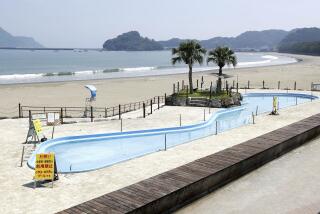For one quake survivor, self-help in the face of seeming helplessness
- Share via
Reporting from Ishinomaki, Japan — — Most of the dozens of tsunami-battered towns along Japan’s northeastern coast remain mired in mud, but the situation in Ishinomaki is a bit different. Nearly a week after the massive earthquake and tsunami hit the city of 162,000, large portions remain underwater, an instant lake clearly visible on NASA satellite photographs.
Amid the aqueous landscape looms Hideaki Akaiwa, 43, in full battle gear.
In a nation of careful dressers, Akaiwa sports Rambo-style army pants, a blue sweatshirt, muddy sneakers, legs wrapped in plastic secured with orange duct tape, and three different backpacks, including an L.L. Bean fanny pack with a tiny plastic anime character affixed, a doctor that saves people.
Photos: Earthquake and nuclear crisis in Japan
Whereas many Japanese have adopted the nation’s unofficial mantra: Shou ga nai, or, more politely, Shikata ga nai, loosely translated as, “What can you do?,” “It’s beyond our control” or “It’s out of my hands,” Akaiwa stands out as a virtual live-action hero.
Akaiwa said he was at work a few miles away when the tsunami hit, and he rushed back to find his neighborhood inundated with up to 10 feet of water. Not willing to wait until the government or any international organization did, or did not, arrive to rescue his wife of two decades — whom he had met while they were surfing in a local bay — Akaiwa got hold of some scuba gear. He then hit the water, wended his way through the debris and underwater hazards and managed to reach his house, from which he dragged his wife to safety.
“The water felt very cold, dark and scary,” he recalled. “I had to swim about 200 yards to her, which was quite difficult with all the floating wreckage.”
With his mother still unaccounted for several days later, Akaiwa stewed with frustration as he watched the water recede by only a foot or two. He repeatedly searched for her at City Hall and nearby evacuation centers.
Finally, on Tuesday, he waded through neck-deep water, searching the neighborhood where she’d last been seen. He found her, he said, on the second floor of a flooded house where she’d been waiting for help for four days.
“She was very much panicked because she was trapped with all this water around,” Akaiwa said. “I didn’t know where she was. It was such a relief to find her.”
Ishinomaki, a rice-shipping port in Miyagi prefecture founded in the fourth century, is known for its huge fish market, a museum devoted to “manga” comic books and a replica of the Statue of Liberty looming over a small island in the Kitakami River.
Now, the still-proud statue looks out over legions of logs liberated from a hidden loading dock. Downtown streets, replete with KFC and Coco’s Restaurant signs, can best be reached by boat.
Two-thousand pound cars have punched their way into tractor trailers, through plate-glass windows, up into trees, defying logic as they to rest bumper-to-bumper in seemingly impossible embraces, all a few hundred yards from blocks of untouched Japanese-style strip malls just beyond the high-water mark, stores with names such as “Beauty Shiny,” “Hotel Kiss” and “Restaurant Joyfill.”
Nearby, battered and bruised residents, bracing for the latest aftershock, walk their bicycles on elevated rail lines, the only high-water refuge for many in this flooded community.
Residents such as office worker Takahiru Haryuu, 47, said Wednesday that they are waiting for authorities to give the all-clear to return to their neighborhoods. Haryuu smoked a cigarette and chatted with his wife Hiroko on an overpass where the city’s four-lane highway ends.
The road wasn’t designed to end here. But now, the newly formed lake extends into his neighborhood, which abuts the sea, its roads and byways still flooded to neck level.
The couple haven’t seen their house since Friday and have no idea what to expect. But they aren’t about to swim or scuba, preferring instead to wait patiently and hope. “The family is all right, thankfully, but we’re very worried about the house,” Haryuu said. “But we’ll just have to keep checking back until we can get in.”
Akaiwai, on the other hand, isn’t big on waiting. He can’t sit still. He pokes around in his car, battered and likely ruined by the tsunami, pointing out a three-inch fish lying dead almost half a mile inland, one of the tsunami’s smallest victims.
Then, he adjusts his pants, reaches into his still-wet car and pulls out a pair of Ray-Ban aviator glasses from a light brown case, pours out the sea water and puts them on to complete his outfit before mounting the bicycle he’s using since his wheels are disabled. Akaiwai next reviews the contents of his fanny pack: green tea, water, a flashlight, camouflage work gloves, a Swiss Army-style knife and a change of clothes.
Finally, he adjusts the grip on his bicycle and heads off in search of other trapped survivors.
“Sorry, I have to get going,” he says as he navigates around the dead fish, through a puddle and around the corner.
Photos: Earthquake and nuclear crisis in Japan
More to Read
Sign up for Essential California
The most important California stories and recommendations in your inbox every morning.
You may occasionally receive promotional content from the Los Angeles Times.










